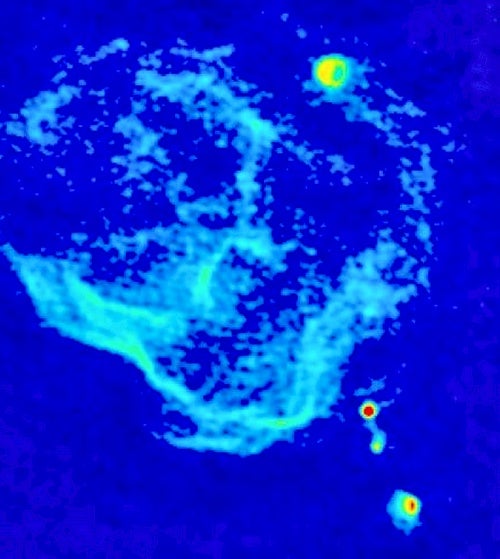Astronomers have discovered a frigid reservoir of simple sugar molecules in Sagittarius B2, a molecular cloud complex located near the center of our Milky Way Galaxy, some 26,000 light-years away. Now, a team led by Jan Hollis of NASA’s Goddard Space Flight Center in Greenbelt, Maryland, has detected faint radio emission from molecules of glycoaldehyde (CH2OHCHO), the simplest sugar.
In 2000, the astronomers detected the molecule in a warmer part of the same cloud, but the new detection shows the sugar exists at a temperature of just 8 kelvins (-445°F) — not much above absolute zero, the temperature at which atoms and molecules have the lowest amount of kinetic energy allowed by the laws of physics. Nevertheless, the cold glycoaldehyde detections were surprisingly strong when compared to the original find, which hints that the cloud contains a considerable quantity of sugar.
On Earth, most chemical reactions occur in liquid water, but in interstellar clouds most complex molecules form on or under the surfaces of tiny dust grains. Smaller molecules — such as water, formaldehyde, methane, ammonia, carbon dioxide, and methanol — coat dust grains in the clouds. Shock waves ripple through the cloud, or nebula, as stars are born and die. When a shock wave hits a dust grain, the energy can help assemble more complex molecules from simpler ones — or shake new-formed molecules off the dust grains, where they can float freely in space.
“Many of the interstellar molecules discovered to date are the same kinds detected in laboratory experiments specifically designed to synthesize prebiotic molecules. This fact suggests a universal prebiotic chemistry,” said Hollis. The molecular building blocks for the creation of life may begin on interstellar dust.
Writing in the September 20 issue of the Astrophysical Journal Letters, the team notes that formation of a planetary system is considered a hot process that would destroy any prebiotic molecules, but the study shows such molecules can form in conditions thought to be typical of the regions surrounding a young solar system. This is also the region where comets form. It has long been suggested, the authors note, that an encounter with a comet — either an impact or a close pass through its dusty tail — might seed a young planet with prebiotic material. The massive Sagittarius B2 cloud is a well-known source of complex molecules, including acetic acid (CH3CO2H), ethanol (C2H5OH) and even glycine (NH2CH2COOH), the simplest amino acid.










